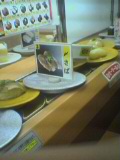I stopped buying macs for personal use after they started charging for .mac e-mail accounts (after they had promised to provide them for free for life). I was the biggest machead until then, but that last act of treachery was the breaking point for me. I also greatly resented the dumbification of the OS and the ever-increasing teeny-bopper trendiness of the brand. That said, I work on a dual processor G4 at work and the G5 came today. And you have to check out this video of the line outside the new Apple Store in Ginza on opening day:
http://homepage.mac.com/hsk/applejapan.html
Also see this WIRED article:
http://www.wired.com/news/mac/0,2125,61513,00.html?tw=wn_tophead_1
Apple has become their 1984 commercial.
Month: December 2003
Finding the One True Way
A recent post about pachinko over at the USS Clueless rubbed me the wrong way. The line that bothered me was:
There’s no skill involved and no real way for the player to increase their chance of winning.
This is just false and I was disappointed to see this on Steven Den Beste’s blog, as he is one of my favorite daily reads. He usually researches his subjects well and writes about them in great detail. Regarding this one specific point, however, he is wrong. There is skill involved and there are ways to increase the odds at winning at pachinko, and good pachinko players use them all. I will not cover cheating or illegal methods in detail here, but rest assured they do exist and people get caught all the time. Actually I know quite a few stories regarding the dark side of pachinko and may cover them in a future post.
My credentials regarding this subject:
I used to play a lot. I have always been lucky at pachinko, which is of course a big reason why I like it. How lucky? Back when I was in university, I could make money off it fairly regularly and probably came out slightly ahead overall (although not enough to forego working part-time). My biggest take for one day was 149,000 yen, over a thousand dollars at the time (winnings aren’t recorded or taxed). My luckiest feat was the time when I walked into a pachinko parlor and picked up two balls that had spilled onto the floor, put them in the machine, sunk the second ball in the center hole, and won 6,000 yen when the machine hit. I fondly remember walking out without gambling any of that money and instead buying dinner for my girlfriend, so you can see that pachinko shares common ground with all other forms of gambling: Knowing when to walk away is key.
Choosing when to play is a major factor for winning at pachinko. It is generally thought that weekends are the worst time to play because the popular parlors are guaranteed high turnout by people who play for fun. The ideal time to go to pachinko is the first few days after the opening of a new parlor. People will wait outside for hours (opening time is almost always 10AM and closing time varies but is usually 11PM) on opening day because the parlor will often set the machines to easier settings to attract a crowd and make a favorable impression with their prospective (return) customers. The second best time to go is when a parlor replaces their old machines with newer types, which usually happens every few months and the frequency of which is a good indicator of how much money the store brings in. At these times as well, the machines are often changed to easier settings for a few days.
The machine has both electronic and mechanical systems that are used to change the payout profile and the chances of winning. The electronics control the “heart” of the game that pays a set jackpot (approximately 4500 – 6000 yen) if matching numbers/characters/symbols line up on the center display, much like a Las Vegas slot machine. The electronics can be set to raise or lower the odds of winning, and there are usually presets numbered 1 to 10, with 1 representing the highest odds of winning. I know this because I have taken several apart for fun (used machines can be bought legally and I’ve found several in the trash).
Unlike a slot machine, the start of the game is not controlled directly by just inserting money and pulling down the arm. You buy the pachinko balls at a set rate (different between regions; Osaka and most of western Japan is set at 4 yen per ball) and use the knob on the lower right side of the machine to control the stream of balls into the area of play. For the vast majority of machines, the object is to get balls to fall into a hole under the center display to trigger the start of the game (this is where action starts on the display). Therefore, the more balls you can get to fall into the “trigger” hole, the better chance you have at winning, and that, in a nutshell, is the primary goal of pachinko – finding the One True Way to the center and into the hole.
This is where the mechanical side of the equation comes in. Between the top of the play area (from which the balls fall down) and the trigger hole there are rows of bronze pins arranged in patterns that determine the flow of the balls when they drop down. The positioning and shape of pins is extremely important to the parlor. They bend them to precisely control how easy it is to get the pachinko balls into the trigger hole. It is a fine art, and more secure than the electronic settings, which can be tampered with by concealed radio transmitters, swapped control chips, or even modified cellphones. There are of course mechanical hacks as well, but they are more visible and almost all parlors have security cameras to catch the low-tech crooks.
As a player, one of the most dramatic ways of increasing your odds is by being able to “read the pins” (Japanese: kugi wo yomu), and choose machines that can be triggered with a minimum expenditure of balls. I often hear tips regarding this subject passed back and forth between pachipro, professionals who are good enough at pachinko to make a living off it. (An example of a typical tip is about looking at the shape of a specific pin on a specific type of machine.) But reading the pins can be done by any level of player who wants to win and is willing to learn through a bit of trial and error (this is also a hook for a future post). By reading the pins, you can also quickly figure out where to aim the flow of balls on the particular machine you have chosen. The faster you can find the One True Way, the more efficiently you can use your supply of balls to trigger the start of the game, and the greater chances you have of winning.
Yoshida
I was happy to see my brother’s name on Instapundit today, although the post wasn’t in reference to him at all. It’s not the first time this Adam Yoshida was mentioned there, but Glenn Reynolds expressed some strong opinions spurred by a recent blog post, which is always significant to a blogger.
I was surprised when I first discovered the existence of another Adam T. Yoshida in this world. I mean, what are the odds on that? They even have the same middle initial! And wonder of wonders: They both have blogs! My original post on the subject is here. Both Adams left comments, which is kind of cool. It’s little things like this that make me especially grateful for the web sometimes. That single comment, just two short sentences, is record of a connection that would never have been made otherwise (my grandchildren will one day assimilate this post with their cortex implants and wonder what the hell I am talking about).
I have a natural interest in the doings of Adam Yoshida Who-Is-Not-My-Brother because of his name, which seems illogical as hell, but what can I say? I read his work online (he is fairly prolific). I am interested in what he has to say even if I don’t always agree. Is it somehow silly or wrong to feel a kind of bond or affinity (I deliberated using the word “kinship” here.) for someone just because they have the same name as you?
I think about this in the real world when I meet other Yoshidas here in Japan. First of all, this is a fairly common occurence because Yoshida has to be one of the top 25 most popular family names here (I do not remember ever having met a Yoshida, of which there are relatively few, who wasn’t somehow related to my family in the states). I had a Yoshida as a counselor at Tenri University, have met some at on the job and others just out on the street. A “warm feeling” from having a common name has always been mutual, I think, although being Japanese (and thus having experienced it more often), they are more used to it, so I may have been imagining it in some cases.
Sushi = Sumo?
While preparing for a post on my moblog, I found a handy list of sushi terminology featuring entries in Japanese kanji/kana and respective romaji readings as well as translations in English and French. Might be handy when we finally visit Sophie’s uncle’s sushi bar in Bordeaux.
The shop is called “Sumo.” I don’t really understand the appeal of this as a name for a sushi bar because it’s said that sumo wrestlers have to eat at least 10,000 calories a day to keep their weight. You would think that trying to scarf down the equivalent in sushi (figure between 40 to 70 calories/piece depending on “topping”) would end gut-bustingly, like Inherit the Wind. Then again, it is a French sushi bar. Maybe they dip everything in mayonnaise? That would make up for the missing calories. Here’s a fun bit of trivia: In France, mayonnaise is packaged in a tube, like toothpaste, and yes, it does squirt like a milked salmon all over your friend’s carpet if you accidentally step on it.
Update: Figured it out. It turns out that Sumo is more than just a run-of-the-mill sushi bar. Its actually known for le repas des sumotori. For a full description, clicke vous (or however you say it in the country that banned the word “e-mail”). Note: It feels very strange to see the words, “le Chankonabe.”
Special Bonus Round Sushi Question: In Japan, the much-beloved fish (among sushi-otaku) called shima-aji is known as a “striped jack” in English and a “sutoraipudo jakku” in Engrish. What is it called in French?
Answer: clicke vous. Just kidding, its a caramgue demtue according to the page I started writing this post about. Unfortunately, I cannot really recommend it as a reference anymore as “caramgue demtue” gets exactly one hit on Google (Heh. Make that two in a couple weeks. I’m honored.) and “demtue” by itself does not appear to be a word at all. The outlandish construct “caramgue” is probably a misspelling of the word “Camargue”, a place in France “where the naked ladies dance”. Oh, it’s also famous for salt. I can’t help but wonder if it’s harvested off the sweaty nekkid dancing ladies, you know, squeezed from their armpit hair during smoking breaks or something.
Logjam

Went to kaiten sushi with Taro and Mimi. A large tuna roll jammed the dishes rotating off the conveyor. A flying fish egg roll almost fell off onto Mimi-chan. The kitchen staff unjammed the mess of plates that were stacking up just in time. Dammit.
Duck and Cover!
I am dropping the design bomb on this site. Time to go fucking nuts, old school style. And when I say old school, I mean bust out the clay tablets and sharpen some sticks yo. After a few hours of tweaking, I usually begin to wonder if my eyes actually see color the same way everybody elses do because its almost impossible to find satisfying combinations. I always seem to spend at least half of the total time on any design project tweaking the last 1%, you know shit like “should I move this pic 1/14th of a pixel to the left,” or, “shouldn’t I add an extra ‘the’ to that last line in order to make it longer?, or, “Was that last optimization really worth the 1.3 bytes that were trimmed from the code… I thought so, let’s do it again.”
I like to think that all the hours I spend making decisions, then reversing them, then reversing them again and again (ad infinitum) are a kind of karmic investment that will somehow be helpful in a future life, cause if they ain’t good for something, someone up there is laughing his ass off at me.
Modern Drunkard

Our friend Frans is a famous university professor in Germany. He has a nice website with respectable looking photos of himself on it. I want the public to know the truth about Frans. Nudie pics with livestock soon to follow.
Octopian

It was one of those “Oh yeah, I’m in a foreign country!” realizations when I came upon a tray of freshly-beheaded yummies of the family Mollusca in a dingy neighborhood supermarket. This store is far enough from Jusco to avoid being consumed this year, and stocks enough weird shit, like beheaded octopuses, to perhaps attract hardcore Japanese gourmands for many years to come. I can only quote X-clan:
“Yuck. Brother J says YUCK.”
Sandpaper AKA Japanese Toilet Paper

The backing of a sheet of my favorite Japanese sandpaper. If only I were kidding…
